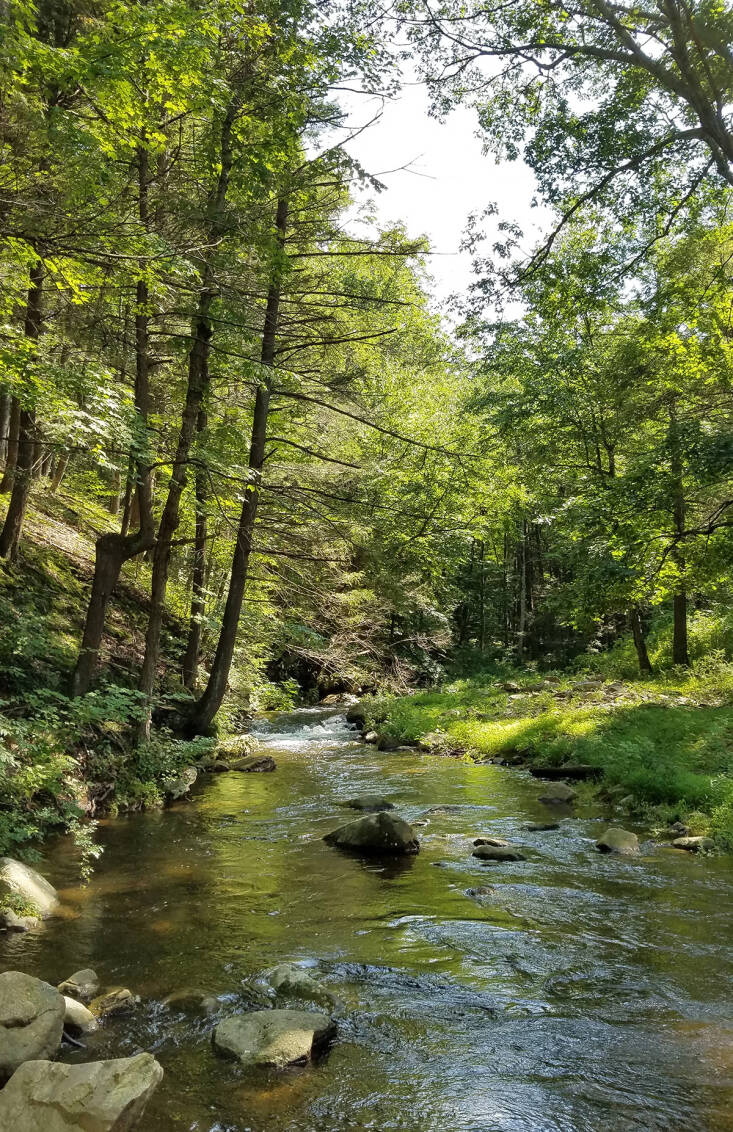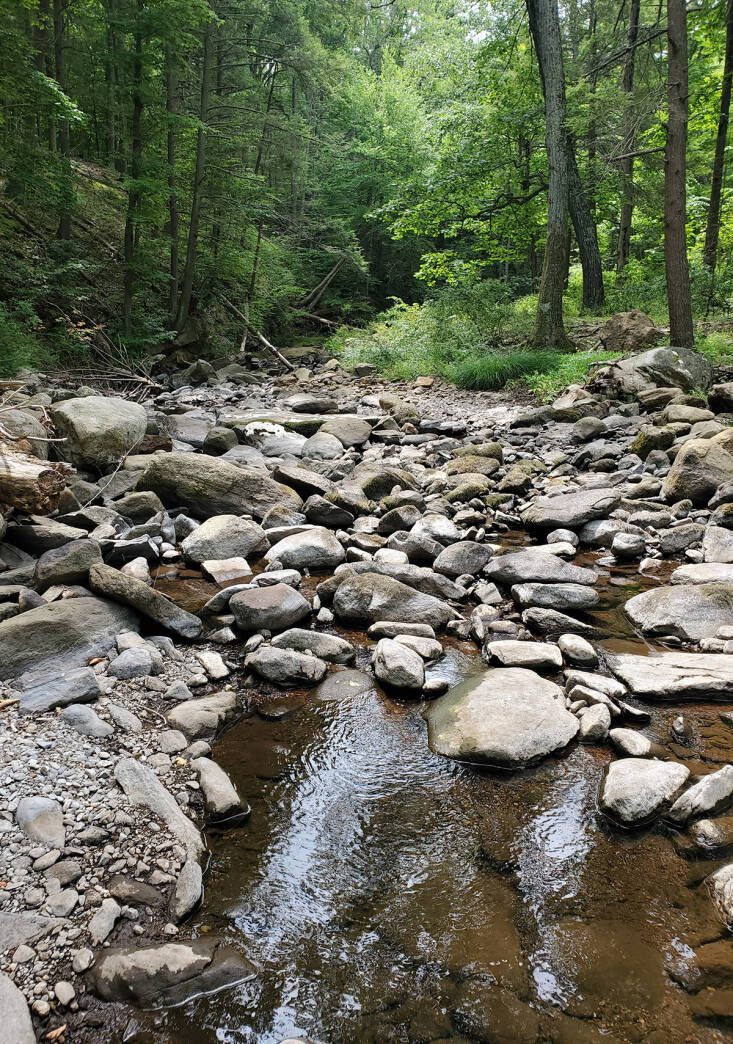If it is hot and oppressively humid, if the air seems riddled with flying insects, and if ticks wave from trail-edge grasses, the mushroom gods are smiling on you: It is time to hunt chanterelles, the delectable ectomycorrhizal mushrooms that fruit after rain has fallen on hardwood forests. In New York’s Hudson Valley chanterelles appear at the claustrophobic height of summer, on the leaf-littered floor beneath their partner-trees. These warm-weather mushrooms also grow in the company of some very curious plants, whose habits and appearance are as interesting as the mushrooms themselves, giving us a glimpse of the teeming subterranean world beneath our hiking feet.
Let’s walk. Bring bug spray.
Photography by Marie Viljoen.

Since chancing upon our first chanterelles in 2018, on a hike an hour north of Manhattan, my husband and I have made a hopeful pilgrimage to the same spot almost every summer. (We had to skip 2020 because the trailhead’s parking area had been transformed into a drive-in COVID testing site.) In the green shade of the cloyingly warm summer woods, we walk swatting at insects, mostly no-see-ums intent on sipping from our eyeballs before becoming trapped in our lashes. There’s quite a lot of swearing. And sweating.

Each walk’s mid-point is a stream where we dip our feet into the clean water and picnic in the company of tiny crayfish and minnows.

We even visited last year, in denial during a months-long drought that crisped the understory and all but dried up the stream. Needless to say, the mushroom world was silent. We wondered if the chanterelles would survive at all. How resilient is a mycelial network? Do their partner-trees’ roots keep them alive?
Mycorrhizal mushrooms grow in symbiosis with green plants; each benefits from the relationship. Ectomycorrhizal mushrooms like chanterelles form sheaths over the root tips of these plants, in this case particular species of trees (here, probably oaks). The mushrooms make minerals from the soil available to the trees, and the photosynthesizing trees send down carbohydrates from the canopy.

One of the first plants to greet us as we walk is pipsissewa, Chimaphila maculata. Also known commonly as prince’s pine and spotted wintergreen, its distinctive evergreen leaves are a welcome sight even on the most bitter of hikes in the middle of winter. Right now winter seems impossible. It is a privilege to see the pretty plants growing here at frequent intervals because pipsissewa is endangered in several states (like Maine), and is considered extirpated in parts of its range.

Beneath the tall trees we follow a path brushed by ferns. Beneath out feet is a hidden world of fungal conversation with tree roots. Soon, we begin to see the now-familiar companions of the mushrooms we are hunting. Plants, yet blanched and alien, they resemble fungi more than anything leafy. They contain no chlorophyll; instead, they are mycoheterotrophs, poaching their nutrition from their mycorrhizal neighbors. These pale denizens of the leaf litter can grow in deep shade, relying on the photosynthesizing trees and the fungal partners that act as essential couriers.
It’s a very open, and very complex, relationship.

If their presence is ubiquitous as we perspire our way along the trial, we take it as is a positive sign in the hunt for our dinner-mushrooms. Ghost pipes’ mushroom partners (the conveyers of nutrition from tree roots) appear to be members of the Russulaceae family, which include Russula and Lactarius genera.

Another poacher is pinesap (Monotropa hypopitys), a wan plant that derives its nutrition from mycorrhiza.

The kernel-like seed capsules of bear corn (Conopholis americana) are disconcerting, like a nightmarish cross between corn and decayed, loose teeth. Bears do in fact eat the plant’s juicy-looking fruits, and it’s not unusual to see a pile of bear scat nearby. Listed as “Exploitably Vulnerable” in New York, bear corn is also known as American cancer root, and is vulnerable to over-harvest.

If high temperatures, rain, and the mysteries of mycelia are in alignment, we find gold sparkling in the leaf litter. It’s a delicious feeling. Squatting low, slicing carefully with our mushroom knives, we forget the besieging flies and the cataracts of perspiration running down our backs. We have found our chanterelles, and our week’s dinners are going to be good.

In a good year, after copious rain, we find the aromatic, meaty mushrooms right beside the path, and in glittering patches under ferns. These are smooth chanterelles, Cantharellus lateritius.


Recently, our mid-July sortie revealed promising flurries of emerging chanterelles, and we collected enough for dinner, leaving the rest to mature (chanterelle mushrooms grow slowly and require consistent moisture for weeks). That night, unprecedented rains broke over the Hudson Valley and caused catastrophic flooding.
When we return we will see how the woods have changed, and whether the mushrooms survived the storms.

Once home, I clean chanterelles by brushing them well, and then I wash the ones we are about to eat, which is heresy to some mushroom hunters. It doesn’t affect their flavor or texture in the slightest. The rest live (unwashed and covered) in the refrigerator until I can process them all: Washing, and cooking them (for pickling, or for freezing).
And then it is time to dine.






Chanterelle Rice
Serves 2 as a side dish
The fruity aroma of chanterelles perfumes rice and pairs very well with other summer flavors, like ripe tomatoes and fresh basil.
- 2 Tablespoons butter
- 1 Tablespoon olive oil
- 1 clove garlic, sliced thinly
- 6 oz chanterelles, cleaned
- ¼ teaspoon salt
- 3 Tablespoons pine nuts
- 1 medium tomato, cut into chunks
- 1 fresh, hot red chile, sliced (optional)
- 8 large basil leaves, whole
- ½ cup basmati rice
- ¾ cup water
In a saucepan, combine the butter and oil over medium-high heat. When the butter has melted add the garlic, chanterelles, and salt, and cook for about 3 minutes, stirring occasionally, as the mushrooms give up their juices and then begin to sizzle. Add the pine nuts, stir well, and add the tomato, and chile (if using). Cook another minute before adding the basil and the rice. Stir to coat the rice well with the juices. Add the water, allow the liquid to boil, then cover the pot. Turn the heat down to its lowest setting and cook until the rice has absorbed all the liquid—about 12 minutes. Fluff it up and serve.
See also:
- Invasivore: Mugwort the Herb vs. Mugwort the Weed
- American Burnweed: A Pungent Summer Herb
- Chickweed: Taste the Stars












Have a Question or Comment About This Post?
Join the conversation (0)